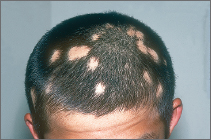AA is a common condition that results in the localized loss of hair on the scalp and possibly on other parts of the body.
Shedding of hair is often first discovered by a family member or a person's hairdresser.
Alopecia areata
AA usually starts with one or more small, smooth, oval or round patches of hair loss.
Hairless spots are most often found on the scalp, but they can also appear on the eyebrows, eyelashes, and areas of the face that bear hair, such as the beard or mustache in men.
Sometimes the patches of hair loss become so large that they may involve the entire head or body. This can be very difficult to treat.
Alopecia areata
AA is considered to be an autoimmune condition (“self-allergy”), because antibodies appear to be attacking the hair follicles.
These antibodies, which are carried by white cells (T cells), cause the growth of hairs to slow and the hairs themselves to become very small. The hairs go into a state resembling hibernation; however, they remain alive below the surface.
Frequently, hair grows back without any treatment; however, it can fall out again.
The regrowing hair is initially thin and sometimes white, but it usually returns to its normal color eventually.
Because mild cases of AA often result in spontaneous regrowth, therapy is often unnecessary.
The spots of hair loss may get bigger before the hair starts to regrow, or more of them may appear while the hair is regrowing. Neither of these conditions is cause for alarm.
The daily application of potent topical steroids, such as _______________, may speed hair regrowth. For increased drug penetration, the topical steroid may be applied to the scalp and covered with a plastic shower cap that is left on overnight.
If necessary, injections of steroids (diluted cortisone) into the bare patches may be given every 6 to 8 weeks.
Other treatments for AA that is not responding include a medication such as _______________.
Alopecia areata


